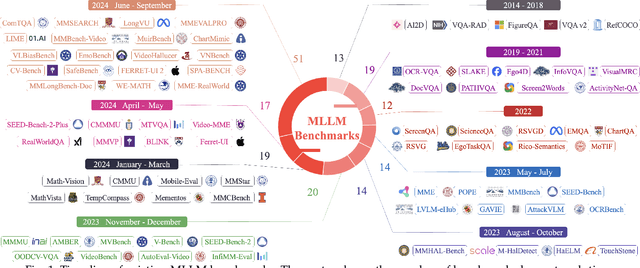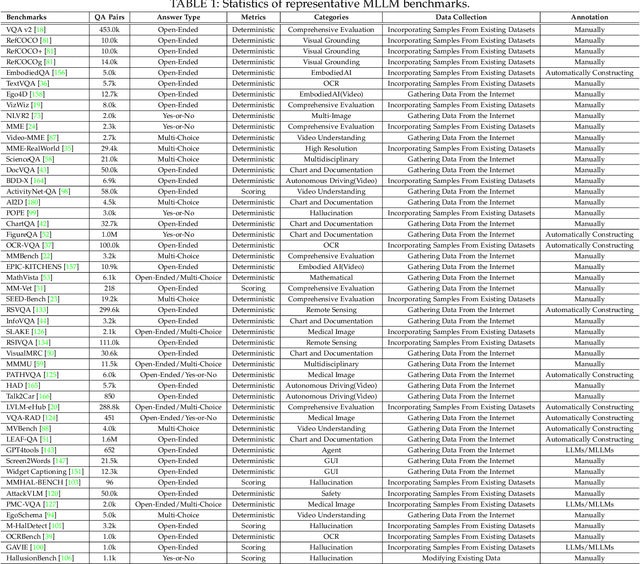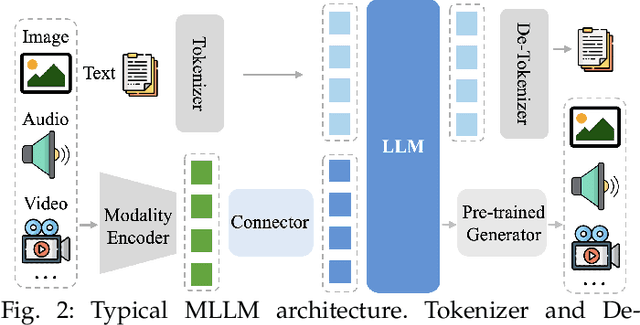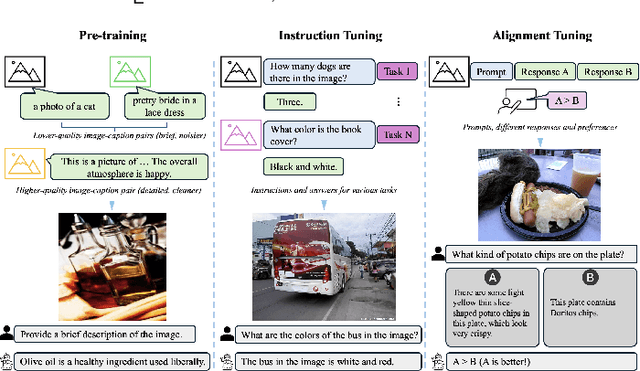Caifeng Shan
VITA-VLA: Efficiently Teaching Vision-Language Models to Act via Action Expert Distillation
Oct 10, 2025Abstract:Vision-Language Action (VLA) models significantly advance robotic manipulation by leveraging the strong perception capabilities of pretrained vision-language models (VLMs). By integrating action modules into these pretrained models, VLA methods exhibit improved generalization. However, training them from scratch is costly. In this work, we propose a simple yet effective distillation-based framework that equips VLMs with action-execution capability by transferring knowledge from pretrained small action models. Our architecture retains the original VLM structure, adding only an action token and a state encoder to incorporate physical inputs. To distill action knowledge, we adopt a two-stage training strategy. First, we perform lightweight alignment by mapping VLM hidden states into the action space of the small action model, enabling effective reuse of its pretrained action decoder and avoiding expensive pretraining. Second, we selectively fine-tune the language model, state encoder, and action modules, enabling the system to integrate multimodal inputs with precise action generation. Specifically, the action token provides the VLM with a direct handle for predicting future actions, while the state encoder allows the model to incorporate robot dynamics not captured by vision alone. This design yields substantial efficiency gains over training large VLA models from scratch. Compared with previous state-of-the-art methods, our method achieves 97.3% average success rate on LIBERO (11.8% improvement) and 93.5% on LIBERO-LONG (24.5% improvement). In real-world experiments across five manipulation tasks, our method consistently outperforms the teacher model, achieving 82.0% success rate (17% improvement), which demonstrate that action distillation effectively enables VLMs to generate precise actions while substantially reducing training costs.
An Effective End-to-End Solution for Multimodal Action Recognition
Jun 11, 2025Abstract:Recently, multimodal tasks have strongly advanced the field of action recognition with their rich multimodal information. However, due to the scarcity of tri-modal data, research on tri-modal action recognition tasks faces many challenges. To this end, we have proposed a comprehensive multimodal action recognition solution that effectively utilizes multimodal information. First, the existing data are transformed and expanded by optimizing data enhancement techniques to enlarge the training scale. At the same time, more RGB datasets are used to pre-train the backbone network, which is better adapted to the new task by means of transfer learning. Secondly, multimodal spatial features are extracted with the help of 2D CNNs and combined with the Temporal Shift Module (TSM) to achieve multimodal spatial-temporal feature extraction comparable to 3D CNNs and improve the computational efficiency. In addition, common prediction enhancement methods, such as Stochastic Weight Averaging (SWA), Ensemble and Test-Time augmentation (TTA), are used to integrate the knowledge of models from different training periods of the same architecture and different architectures, so as to predict the actions from different perspectives and fully exploit the target information. Ultimately, we achieved the Top-1 accuracy of 99% and the Top-5 accuracy of 100% on the competition leaderboard, demonstrating the superiority of our solution.
Learning Knowledge-based Prompts for Robust 3D Mask Presentation Attack Detection
May 06, 2025Abstract:3D mask presentation attack detection is crucial for protecting face recognition systems against the rising threat of 3D mask attacks. While most existing methods utilize multimodal features or remote photoplethysmography (rPPG) signals to distinguish between real faces and 3D masks, they face significant challenges, such as the high costs associated with multimodal sensors and limited generalization ability. Detection-related text descriptions offer concise, universal information and are cost-effective to obtain. However, the potential of vision-language multimodal features for 3D mask presentation attack detection remains unexplored. In this paper, we propose a novel knowledge-based prompt learning framework to explore the strong generalization capability of vision-language models for 3D mask presentation attack detection. Specifically, our approach incorporates entities and triples from knowledge graphs into the prompt learning process, generating fine-grained, task-specific explicit prompts that effectively harness the knowledge embedded in pre-trained vision-language models. Furthermore, considering different input images may emphasize distinct knowledge graph elements, we introduce a visual-specific knowledge filter based on an attention mechanism to refine relevant elements according to the visual context. Additionally, we leverage causal graph theory insights into the prompt learning process to further enhance the generalization ability of our method. During training, a spurious correlation elimination paradigm is employed, which removes category-irrelevant local image patches using guidance from knowledge-based text features, fostering the learning of generalized causal prompts that align with category-relevant local patches. Experimental results demonstrate that the proposed method achieves state-of-the-art intra- and cross-scenario detection performance on benchmark datasets.
Fast Adversarial Training with Weak-to-Strong Spatial-Temporal Consistency in the Frequency Domain on Videos
Apr 21, 2025Abstract:Adversarial Training (AT) has been shown to significantly enhance adversarial robustness via a min-max optimization approach. However, its effectiveness in video recognition tasks is hampered by two main challenges. First, fast adversarial training for video models remains largely unexplored, which severely impedes its practical applications. Specifically, most video adversarial training methods are computationally costly, with long training times and high expenses. Second, existing methods struggle with the trade-off between clean accuracy and adversarial robustness. To address these challenges, we introduce Video Fast Adversarial Training with Weak-to-Strong consistency (VFAT-WS), the first fast adversarial training method for video data. Specifically, VFAT-WS incorporates the following key designs: First, it integrates a straightforward yet effective temporal frequency augmentation (TF-AUG), and its spatial-temporal enhanced form STF-AUG, along with a single-step PGD attack to boost training efficiency and robustness. Second, it devises a weak-to-strong spatial-temporal consistency regularization, which seamlessly integrates the simpler TF-AUG and the more complex STF-AUG. Leveraging the consistency regularization, it steers the learning process from simple to complex augmentations. Both of them work together to achieve a better trade-off between clean accuracy and robustness. Extensive experiments on UCF-101 and HMDB-51 with both CNN and Transformer-based models demonstrate that VFAT-WS achieves great improvements in adversarial robustness and corruption robustness, while accelerating training by nearly 490%.
LAD-Reasoner: Tiny Multimodal Models are Good Reasoners for Logical Anomaly Detection
Apr 17, 2025Abstract:Recent advances in industrial anomaly detection have highlighted the need for deeper logical anomaly analysis, where unexpected relationships among objects, counts, and spatial configurations must be identified and explained. Existing approaches often rely on large-scale external reasoning modules or elaborate pipeline designs, hindering practical deployment and interpretability. To address these limitations, we introduce a new task, Reasoning Logical Anomaly Detection (RLAD), which extends traditional anomaly detection by incorporating logical reasoning. We propose a new framework, LAD-Reasoner, a customized tiny multimodal language model built on Qwen2.5-VL 3B. Our approach leverages a two-stage training paradigm that first employs Supervised Fine-Tuning (SFT) for fine-grained visual understanding, followed by Group Relative Policy Optimization (GRPO) to refine logical anomaly detection and enforce coherent, human-readable reasoning. Crucially, reward signals are derived from both the detection accuracy and the structural quality of the outputs, obviating the need for building chain of thought (CoT) reasoning data. Experiments on the MVTec LOCO AD dataset show that LAD-Reasoner, though significantly smaller, matches the performance of Qwen2.5-VL-72B in accuracy and F1 score, and further excels in producing concise and interpretable rationales. This unified design reduces reliance on large models and complex pipelines, while offering transparent and interpretable insights into logical anomaly detection. Code and data will be released.
Anti-Aesthetics: Protecting Facial Privacy against Customized Text-to-Image Synthesis
Apr 16, 2025Abstract:The rise of customized diffusion models has spurred a boom in personalized visual content creation, but also poses risks of malicious misuse, severely threatening personal privacy and copyright protection. Some studies show that the aesthetic properties of images are highly positively correlated with human perception of image quality. Inspired by this, we approach the problem from a novel and intriguing aesthetic perspective to degrade the generation quality of maliciously customized models, thereby achieving better protection of facial identity. Specifically, we propose a Hierarchical Anti-Aesthetic (HAA) framework to fully explore aesthetic cues, which consists of two key branches: 1) Global Anti-Aesthetics: By establishing a global anti-aesthetic reward mechanism and a global anti-aesthetic loss, it can degrade the overall aesthetics of the generated content; 2) Local Anti-Aesthetics: A local anti-aesthetic reward mechanism and a local anti-aesthetic loss are designed to guide adversarial perturbations to disrupt local facial identity. By seamlessly integrating both branches, our HAA effectively achieves the goal of anti-aesthetics from a global to a local level during customized generation. Extensive experiments show that HAA outperforms existing SOTA methods largely in identity removal, providing a powerful tool for protecting facial privacy and copyright.
Exploring Adversarial Transferability between Kolmogorov-arnold Networks
Mar 08, 2025Abstract:Kolmogorov-Arnold Networks (KANs) have emerged as a transformative model paradigm, significantly impacting various fields. However, their adversarial robustness remains less underexplored, especially across different KAN architectures. To explore this critical safety issue, we conduct an analysis and find that due to overfitting to the specific basis functions of KANs, they possess poor adversarial transferability among different KANs. To tackle this challenge, we propose AdvKAN, the first transfer attack method for KANs. AdvKAN integrates two key components: 1) a Breakthrough-Defense Surrogate Model (BDSM), which employs a breakthrough-defense training strategy to mitigate overfitting to the specific structures of KANs. 2) a Global-Local Interaction (GLI) technique, which promotes sufficient interaction between adversarial gradients of hierarchical levels, further smoothing out loss surfaces of KANs. Both of them work together to enhance the strength of transfer attack among different KANs. Extensive experimental results on various KANs and datasets demonstrate the effectiveness of AdvKAN, which possesses notably superior attack capabilities and deeply reveals the vulnerabilities of KANs. Code will be released upon acceptance.
VITA-1.5: Towards GPT-4o Level Real-Time Vision and Speech Interaction
Jan 03, 2025



Abstract:Recent Multimodal Large Language Models (MLLMs) have typically focused on integrating visual and textual modalities, with less emphasis placed on the role of speech in enhancing interaction. However, speech plays a crucial role in multimodal dialogue systems, and implementing high-performance in both vision and speech tasks remains a significant challenge due to the fundamental modality differences. In this paper, we propose a carefully designed multi-stage training methodology that progressively trains LLM to understand both visual and speech information, ultimately enabling fluent vision and speech interaction. Our approach not only preserves strong vision-language capacity, but also enables efficient speech-to-speech dialogue capabilities without separate ASR and TTS modules, significantly accelerating multimodal end-to-end response speed. By comparing our method against state-of-the-art counterparts across benchmarks for image, video, and speech tasks, we demonstrate that our model is equipped with both strong visual and speech capabilities, making near real-time vision and speech interaction.
T2Vid: Translating Long Text into Multi-Image is the Catalyst for Video-LLMs
Dec 02, 2024



Abstract:The success of Multimodal Large Language Models (MLLMs) in the image domain has garnered wide attention from the research community. Drawing on previous successful experiences, researchers have recently explored extending the success to the video understanding realms. Apart from training from scratch, an efficient way is to utilize the pre-trained image-LLMs, leading to two mainstream approaches, i.e. zero-shot inference and further fine-tuning with video data. In this work, our study of these approaches harvests an effective data augmentation method. We first make a deeper inspection of the zero-shot inference way and identify two limitations, i.e. limited generalization and lack of temporal understanding capabilities. Thus, we further investigate the fine-tuning approach and find a low learning efficiency when simply using all the video data samples, which can be attributed to a lack of instruction diversity. Aiming at this issue, we develop a method called T2Vid to synthesize video-like samples to enrich the instruction diversity in the training corpus. Integrating these data enables a simple and efficient training scheme, which achieves performance comparable to or even superior to using full video datasets by training with just 15% the sample size. Meanwhile, we find that the proposed scheme can boost the performance of long video understanding without training with long video samples. We hope our study will spark more thinking about using MLLMs for video understanding and curation of high-quality data. The code is released at https://github.com/xjtupanda/T2Vid.
MME-Survey: A Comprehensive Survey on Evaluation of Multimodal LLMs
Nov 22, 2024



Abstract:As a prominent direction of Artificial General Intelligence (AGI), Multimodal Large Language Models (MLLMs) have garnered increased attention from both industry and academia. Building upon pre-trained LLMs, this family of models further develops multimodal perception and reasoning capabilities that are impressive, such as writing code given a flow chart or creating stories based on an image. In the development process, evaluation is critical since it provides intuitive feedback and guidance on improving models. Distinct from the traditional train-eval-test paradigm that only favors a single task like image classification, the versatility of MLLMs has spurred the rise of various new benchmarks and evaluation methods. In this paper, we aim to present a comprehensive survey of MLLM evaluation, discussing four key aspects: 1) the summarised benchmarks types divided by the evaluation capabilities, including foundation capabilities, model self-analysis, and extented applications; 2) the typical process of benchmark counstruction, consisting of data collection, annotation, and precautions; 3) the systematic evaluation manner composed of judge, metric, and toolkit; 4) the outlook for the next benchmark. This work aims to offer researchers an easy grasp of how to effectively evaluate MLLMs according to different needs and to inspire better evaluation methods, thereby driving the progress of MLLM research.
 Add to Chrome
Add to Chrome Add to Firefox
Add to Firefox Add to Edge
Add to Edge